Narendra Modi
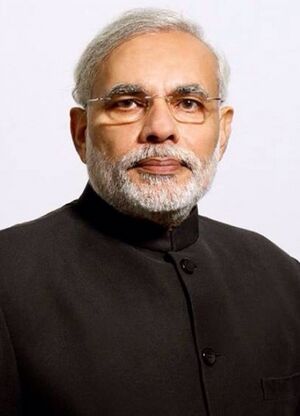
Narendra Damodardas Modi born 17 September 1950) is the 14th and current Prime Minister of India, in office since 26 May 2014. Modi, a leader of the Bharatiya Janata Party (BJP), was the Chief Minister of the western Indian state of Gujarat from 2001 to 2014, and is currently a Member of the Parliament from Varanasi. He took office as the Prime Minister after the 2014 general election, in which his party (BJP) won a majority in the Lok Sabha (the lower house of the Indian parliament), for the first time since 1984 general elections.
As Prime Minister, Modi's administration has focused on reforming and modernising India's infrastructure and government, reducing bureaucracy, encouraging increased foreign direct investment, improving national standards of health and sanitation and improving foreign relations. Earlier, as Chief Minister of Gujarat, Modi's economic policies (credited with encouraging economic growth in Gujarat) have been praised, although his administration has been criticised for failing to significantly improve the human development in the state and for failing to prevent the 2002 Gujarat riots. A Hindu nationalist and member of the Rashtriya Swayamsevak Sangh (RSS), Modi remains a controversial figure domestically and internationally.
Early life and education
Narendra Modi was born on 17 September 1950 to a family of grocers in Vadnagar, Mehsana district, Bombay State (present-day Gujarat). He was the third of six children born to Damodardas Mulchand Modi and Hiraben Modi. Modi's family belonged to the Modh-Ghanchi-Teli (oil-presser) community.
As a child, Modi helped his father sell tea at the Vadnagar railway station, and later ran a tea stall with his brother near a bus terminus. Modi completed his higher secondary education in Vadnagar in 1967, where a teacher described him as an average student and a keen debater, with an interest in theatre.
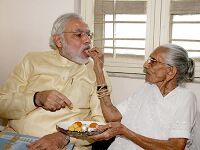
At age eight, Modi discovered the Rashtriya Swayamsevak Sangh (RSS), and began attending its local shakhas (training sessions). There, Modi met Lakshmanrao Inamdar, popularly known as Vakil Saheb, who inducted him as a balswayamsevak (junior cadet) for RSS and became his political mentor. While Modi was training with the RSS, he also met Vasant Gajendragadkar and Nathalal Jaghda, Bharatiya Jana Sangh leaders who were founding members of the BJP's Gujarat unit in 1980.
Engaged while still a child to a local girl, Jashodaben Narendrabhai Modi, Modi rejected the arranged marriage at the same time he graduated from high school. The resulting familial tensions contributed to his decision to leave home in 1967.
Modi spent the ensuing two years travelling across Northern and North-eastern India, though few details of where he went have emerged. In interviews, Modi has described visiting Hindu ashrams founded by Swami Vivekananda: the Belur Math near Kolkata, followed by the Advaita Ashrama in Almora and the Ramakrishna Mission in Rajkot. Modi remained only a short time at each, since he lacked the required college education. "Modi's life is said to have Vivekananda's deep influence. People close to Modi have often been quoted, saying that Modi has molded many aspects of his life as Vivekananda's."
Reaching the Belur Math in the early summer of 1968 and being turned away, Modi wandered through Calcutta, West Bengal and Assam, stopping by Siliguri and Guwahati. Modi then went to the Ramakrishna Ashram in Almora, where he was again rejected, before travelling back to Gujarat via Delhi and Rajasthan in 1968-69. Sometime in late 1969 or early 1970, Modi returned to Vadnagar for a brief visit before leaving again for Ahmedabad. There, Modi lived with his uncle, working in the latter's canteen at the Gujarat State Road Transport Corporation.
In Ahmedabad, Modi renewed his acquaintance with Inamdar, who was based at Hedgewar Bhavan (RSS headquarters) in the city. After the Indo-Pakistani War of 1971, he stopped working for his uncle and became a full-time pracharak (campaigner) for the RSS. In 1978, Modi became an RSS sambhag pracharak (regional organiser), and received a degree in Political Science after a distance-education course from Delhi University.
Early political career, 1975–2001
On 26 June 1975, Prime Minister Indira Gandhi declared a state of emergency in India which lasted until 1977. During this period, many of her political opponents were jailed and opposition groups (including the RSS) were banned. As pracharak in-charge of the Akhil Bharatiya Vidyarthi Parishad (ABVP), the student wing of the RSS, Modi was forced to go underground in Gujarat and frequently travelled in disguise to avoid arrest. He became involved in printing pamphlets opposing the government, sending them to Delhi and organising demonstrations. During this period, Modi wrote a book in Gujarati, Sangharsh ma Gujarat (The Struggles of Gujarat), describing events during the Emergency.
He was assigned by the RSS to the BJP in 1985. In 1988, Modi was elected organising secretary of the party's Gujarat unit, marking his entrance into electoral politics. He rose within the party, helping organise L. K. Advani's 1990 Ram Rath Yatra in 1990 and Murli Manohar Joshi's 1991–92 Ekta Yatra (Journey for Unity). In November of that year Modi was elected BJP national secretary and transferred to New Delhi, where he assumed responsibility for party activities in Haryana and Himachal Pradesh. The following year, Shankersinh Vaghela (one of the most prominent BJP leaders in Gujarat) defected to the INC after losing his parliamentary seat in the Lok Sabha elections.
Chief Minister of Gujarat (2001–14)
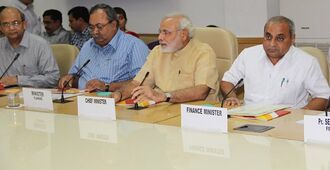
In 2001, Patel's health was failing and the BJP had lost seats in the by-elections. Allegations of abuse of power, corruption and poor administration were made, and Patel's standing had been damaged by his administration's handling of the 2001 Bhuj earthquake. The BJP national leadership sought a new candidate for chief minister, and Modi (who had expressed misgivings about Patel's administration) was chosen as a replacement. Although Advani did not want to ostracise Patel and was concerned about Modi's lack of experience in government, Modi declined an offer to be Patel's deputy chief minister and told Advani and Atal Bihari Vajpayee he was "going to be fully responsible for Gujarat or not at all". On 3 October 2001 he replaced Patel as Chief Minister of Gujarat, with the responsibility of preparing the BJP for the December 2002 elections. As Chief Minister, Modi favoured privatisation and small government; this was at odds with political commentator Aditi Phadnis' description of the RSS as anti-privatisation and anti-globalisation.
First term, 2001–02
On 7 October 2001, Modi was administered the oath of office. On 24 February 2002 he won a by-election to the Rajkot – II assembly constituency, defeating Ashwin Mehta of the Indian National Congress (INC) by 14,728 votes.
2002 Gujarat riots
On 27 February 2002, a train with several hundred passengers, was burned near Godhra killing about 60 people. while The Guardian put the figure at 60. The train carried a large number of Hindu pilgrims returning from Ayodhya after a religious ceremony at the site of the demolished Babri Masjid. In the wake of rumours that the fire was set by Muslim arsonists, anti-Muslim violence spread through Gujarat. Estimates of that death toll ranged from 900 to over 2,000, with several thousand injured. The Modi government imposed a curfew in major cities, issued shoot-at-sight orders and called for the army to prevent the violence from escalating, but human rights organisations, opposition parties and some media accused the Gujarat government of taking insufficient action against the riots (to the point of condoning them). Modi's decision to move the bodies of the Kar Sevak train victims from Godhra to Ahmedabad was criticised for inflaming the violence.
In March 2008, the Supreme Court asked the state government to re-investigate nine cases from the 2002 riots (including the Gulbarg Society massacre), establishing a Special Investigation Team (SIT). In response to a petition from Zakia Jafri (widow of Ehsan Jafri, who was killed in the Gulbarg Society massacre), in April 2009 the court asked the SIT to investigate her allegation that Modi and another minister were complicit in the killings. The SIT questioned Modi in March 2010; in May, it presented to the court a report finding no evidence to substantiate the allegations. In July 2011, amicus curiae Raju Ramachandran submitted his final report to the court: contrary to the SIT position, Modi could be prosecuted based on the available evidence. The team criticised Ramachandran's report for relying on testimony from Sanjiv Bhatt, who they said fabricated the documents used as evidence. The Supreme Court gave the matter to the magistrate court, with the SIT examining Ramachandran's report. The team submitted its final report in March 2012 seeking closure of the case, with Zakia Jaffri filing a protest petition in response. In December 2013 the magistrate court rejected the protest petition, accepting the SIT's finding that there was no evidence against the chief minister.
Modi's involvement in the 2002 events has continued to be debated. Several scholars have described them as a pogrom, while others have called them state terrorism. Summarising academic views on the subject, Martha Nussbaum said: "There is by now a broad consensus that the Gujarat violence was a form of ethnic cleansing, that in many ways it was premeditated, and that it was carried out with the complicity of the state government and officers of the law." In 2012 Maya Kodnani, a minister in Modi's government from 2007 to 2009, was convicted of participation in the Naroda Patiya massacre during the 2002 riots. Kodnani was the first woman and the first MLA to be convicted in a Godhra-riots case. Although Modi's government had announced that it would seek the death penalty for Kodnani on appeal, in 2013 it retreated from that stance.
Later in 2002, Modi said the way in which he had handled the media was his only regret regarding the episode. He subsequently claimed that some journalists at India's NDTV channel had acted irresponsibly in their coverage of the events.
2002 election
In the aftermath of the violence came widespread calls for Modi to resign as chief minister from within and outside the state, including leaders of the Dravida Munnetra Kazhagam and the Telugu Desam Party (allies in the BJP-led National Democratic Alliance coalition), and opposition parties stalled Parliament over the issue. Modi submitted his resignation, which was not accepted, at the April 2002 BJP national executive meeting in Goa. His cabinet had a 19 July 2002 emergency meeting, offered its resignation to the Gujarat Governor S. S. Bhandari and the assembly was dissolved. In the subsequent elections, the BJP won 127 seats in the 182-member assembly. Although Modi later denied it, he made significant use of anti-Muslim rhetoric during his campaign. He won the Maninagar constituency, receiving 1,13,589 of 1,54,981 votes and defeating INC candidate Yatin Oza by 75,333 votes. On 22 December 2002, Bhandari swore Modi in for a second term.
Second term, 2002–07
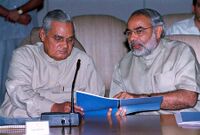
After accusations of anti-Muslim rhetoric during the campaign, during Modi's second term his emphasis shifted from Hindutva to Gujarat's economic development. entrenched in the state after the decline of Ahmedabad's textile industry, and dropped Gordhan Zadafia (an ally of former Sangh co-worker and VHP state chief Praveen Togadia) from his cabinet. When the BKS staged a farmers' demonstration Modi ordered their eviction from state-provided houses, and his decision to demolish 200 illegal temples in Gandhinagar deepened the rift with the VHP. Sangh organisations were no longer consulted or informed in advance about Modi's administrative decisions.
His 2002–07 changes have led to Gujarat's description as an attractive investment destination. According to Aditi Phadnis, "There was sufficient anecdotal evidence pointing to the fact that corruption had gone down significantly in the state. if there was to be any corruption, Modi had to know about it". He established financial and technology parks in Gujarat and during the 2007 Vibrant Gujarat summit, real-estate investment deals worth 6.6 trillion were signed in the state.
Despite his second-term focus on economic issues, Modi's relationship with Muslims continued to be criticised. Prime Minister Atal Bihari Vajpayee (who asked Modi for tolerance in the aftermath of the 2002 Gujarat violence and supported his resignation as chief minister) distanced himself, reaching out to North Indian Muslims before the 2004 Lok Sabha elections. After the elections Vajpayee called the violence in Gujarat a reason for the BJP's electoral defeat and said it had been a mistake to leave Modi in office after the riots.
2007 election
During the run-up to the 2007 assembly elections and the 2009 general election, the BJP ramped up its rhetoric on terrorism. On 18 July 2006, Modi criticised Prime Minister Manmohan Singh " ... for his reluctance to revive anti-terror legislation" such as the 2002 Prevention of Terrorism Act. He asked the national government to allow states to invoke tougher laws in the wake of the 2006 Mumbai blasts and demanded the execution of Afzal Guru, a collaborator with Pakistani jihadists who was convicted of terrorism for his involvement in the 2001 Indian Parliament attack. Afzal Guru was executed on 9 February 2013. There had been BJP allegations that the government's delaying of the execution for so long was an attempt to ensure that the Muslim vote was not lost. After the November 2008 Mumbai attacks Modi held a meeting to discuss the security of Gujarat's -long coastline, resulting in government authorisation of 30 high-speed surveillance boats. In July 2007 Modi completed 2,063 consecutive days as chief minister of Gujarat (making him the longest-serving holder of that post), and the BJP won 122 of 182 state-assembly seats in that year's election.
Third term, 2007–12
Projects
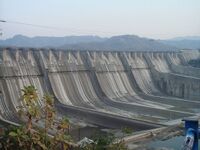
Keshubhai Patel and Modi's BJP governments supported NGOs and communities in the creation of groundwater-conservation projects; according to Tushaar Shah, Gujarat (a semi-arid state) was never known for agrarian dynamism". By December 2008 500,000 structures were built, of which 113,738 were check dams. While most check-dam impoundments dried up during the pre-monsoon period, they helped monsoon rains recharge the aquifers beneath them. Sixty of the 112 tehsils which were found to have depleted the water table in 2004 had regained their normal groundwater levels by 2010, and Gujarat increased its groundwater levels when they were falling in all other Indian states. As a result, the state's production of genetically modified Bt cotton (which could now be irrigated with tube wells) increased to become the largest in India. saw Gujarat's agricultural growth increase to 9.6 percent from 2001 to 2007. Although public irrigation measures in central and southern Gujarat (such as the Sardar Sarovar Dam) have been less successful, from 2001 to 2010 Gujarat recorded an agricultural growth rate of 10.97 percent – the highest of any state. However, sociologists have pointed out that the growth rate under the 1992–97 INC government was 12.9 percent.
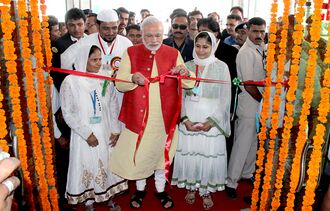
The Modi government brought electricity to every village in Gujarat, although according to Dipankar Banerjee all but 170 villages had been electrified under the INC administration. "Business Standard Vibrant Gujarat" Modi significantly changed the state's system of power distribution, greatly impacting farmers. Gujarat expanded the Jyotigram Yojana scheme, in which agricultural electricity was separated from other rural electricity; the agricultural electricity was rationed to fit scheduled irrigation demands, reducing its cost. Although early protests by farmers ended when those who benefited found that their electricity supply had stabilised, according to an assessment study corporations and large farmers benefited from the policy at the expense of small farmers and labourers.
Progress was made on the Gujarat International Finance Tec-City project, considered one of Modi's pet projects. Its first phase, consisting of two skyscrapers (GIFT One and Two), was completed in 2012.
He celebrated the year 2012 as Swami Vivekananda's 150th anniversary year in Gujarat.
Development debate
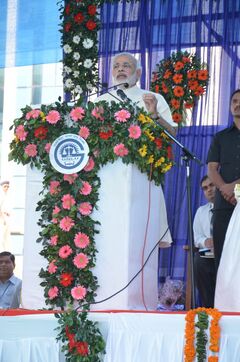
Modi's administration branded Gujarat as a state of dynamic development, economic growth and prosperity with the slogan, "Vibrant Gujarat". Scholars have stated that Gujarat's rate of economic growth had been high even before Modi's tenure, and did not accelerate after he came to power. During Modi's tenure as Chief Minister, Gujarat topped the World Bank's "ease of doing business" rankings among Indian states for two consecutive years. In 2013, Gujarat was ranked first among Indian states for "economic freedom" by a report measuring governance, growth, citizens' rights and labour and business regulation among the country's 20 largest states. However, critics have pointed to its relatively poor record on human development, poverty relief, nutrition and education. Gujarat ranks 13th in India in poverty and 21st in education. Nearly 45 percent of children under five are underweight and 23 percent are undernourished, putting the state in the "alarming" category on the India State Hunger Index. In a review of the 1894 Land Acquisition Act, the Supreme Court of India identified Gujarat as one of the few states from which there were no complaints of forcible land acquisition.
According to political scientist Christophe Jaffrelot, development in Gujarat has been limited to the urban middle class as rural residents and the lower castes have become increasingly marginalised. The state ranks 10th of the 21 Indian states in the Human Development Index, which he attributes to less rural development. Jaffrelot says that under Modi the number of families below the poverty line has increased and conditions for rural adivasi and dalits, in particular, have declined. In July 2013 economics Nobel Laureate Amartya Sen expressed disapproval of Modi's governance record, saying that under his administration Gujarat's "record in education and healthcare is pretty bad". However, economists Arvind Panagariya and Jagdish Bhagwati say that Gujarat's social indicators have improved from a lower baseline than that of other Indian states. According to them, Gujarat's performance in raising literacy rates has been superior to other states and the "rapid" improvement of health indicators is evidence that "its progress has not been poor by any means."
Fourth term, 2012–14
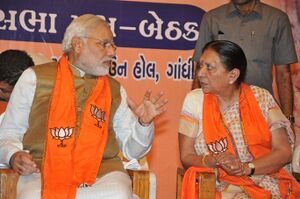
In the 2012 Gujarat Legislative Assembly elections, Modi won the constituency of Maninagar by 86,373 votes over Shweta Bhatt, the INC candidate and wife of Sanjiv Bhatt. The BJP won 115 of the 182 seats, continuing its majority during his tenure and allowing the party to form the government (as it had in Gujarat since 1995). In later by-elections the BJP won four more assembly seats and two Lok Sabha seats held by the INC, although Modi did not campaign for its candidates. In 2013, the Wharton India Economic Forum (WIEF) at the Wharton School of the University of Pennsylvania cancelled a keynote video-conference speech by Modi following protests by Indian-Americans. After his election as prime minister, Modi resigned as the chief minister and as an MLA from Maninagar on 21 May 2014. Anandiben Patel succeeded him as the chief minister.
International diplomacy
To attract foreign investment to Gujarat when he was chief minister, Modi visited China, Singapore and Japan, travelling to China in November 2006 (to study the country's special economic zones, about to be implemented in Gujarat), September 2007 and November 2011. A month after his 2011 visit, the Chinese government released 13 Indian diamond traders charged with smuggling in Shenzhen, with Modi attributing their release to his diplomacy and statesmanship.
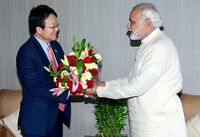
His relationship with many Western nations was troubled during his tenure as chief minister, with questions about his role in the 2002 riots resulting in travel bans to the UK, the US and the EU. Modi was barred from entering the United States under a provision of the Immigration and Nationality Act banning violators of religious freedom, the only person denied a US visa under this provision. The UK and the European Union refused to admit him because of what they saw as his role in the riots. As Modi rose to prominence in India, the UK lifted their bans in October 2012 and March 2013, respectively, and after his election as prime minister he was invited to Washington. Regarding the United States of America (U.S.), on 16 March 2005, Rep. Conyers and Rep. Pitts in the U.S. House of Representatives in Congress, submitted H.RES.160, banning Narendra Modi, the Chief Minister of the State of Gujarat in India from entering the U.S. indefinitely. The title of the document is: "Condemning the conduct of Chief Minister Narendra Modi for his actions to incite religious persecution and urging the United States to condemn all violations of religious freedom in India." The document contains this quote: "Whereas the USCIRF has confirmed in its May 2004 report that the state government in Gujarat led by Chief Minister Modi has been widely accused of being reluctant to bring the perpetrators of the killings of Muslims and non-Hindus to justice." On 16 May 2014, Narendra Modi was elected the 15th Prime Minister of India, in the largest Democratic election ever held on Earth. On 14 June 2014, Senator Barbara Boxer (D-California) and nine of her colleagues in the U.S. Senate sent a joint letter to newly elected Prime Minister Modi with the following title: "Boxer, Colleagues Urge Indian Prime Minister to Improve Safety of Women in India". On 8 June 2016, Prime Minister Narendra Modi of India addressed a joint session of the U.S. Congress.
In 2011, the Karachi Chamber of Commerce & Industry, impressed with development in Gujarat, invited Modi to visit Pakistan and address business leaders who asked him to consider a flight between Ahmedabad and Karachi because of the cultural and economic relationships between Gujarat and Sindh. Modi wanted to ease Pakistan's power crisis, particularly in Sindh, and suggested that the country could follow the examples of the "Gujarat model" set by Gujarat Solar Park and the Kalpasar Project. In an April 2014 statement described as "unexpected", senior Pakistani diplomats told The Daily Telegraph that Modi was their choice for India's prime Minister "as he could provide the strong leadership necessary for peace talks".
Modi visited Japan in 2012. According to Ryohei Kasai, research fellow at the Center for South Asian Studies at Gifu Women's University, "There is a growing interest in Modi in Japan with much anticipation that he will reshape India by revitalising its economy and better governance. I believe Japan has an excellent relationship with him. Not only have successive Japanese ambassadors to India been regular guests in 'Vibrant Gujarat' investors' summit (organised biennially) but Japanese private companies also made a big amount of investment in the state."
2014 Indian general election
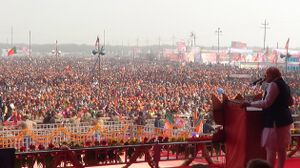
On 31 March 2013 Modi was appointed to the BJP parliamentary board, the highest decision-making body in the party, and at a meeting of the party's national executive on 9 June he was appointed chair of the BJP's central election campaign committee for the 2014 general election. BJP founding member L. K. Advani resigned his party posts after the appointment, citing concern with leaders who were "concerned with their personal agendas". His resignation, which was described as being a protest against Modi's elevation, was withdrawn the following day at the urging of RSS chief Mohan Bhagwat. In September 2013, the BJP announced that the chief minister would be their candidate for prime minister in the 2014 Lok Sabha election. Other BJP leaders also initially expressed opposition to Modi's candidature. Modi's nomination also drew attention for his reputation as "one of contemporary India’s most controversial and divisive politicians."
Modi played a dominant role in the BJP's 2009 general-election campaign. Several people who voted for the BJP stated that if Modi had not been the prime-ministerial candidate, they would have voted for another party. The BJP projected an image of Modi as a strong, masculine leader, who would be able to take difficult decisions. The election was described as a referendum on Narendra Modi.
During the campaign, Modi focused on the corruption scandals under the previous INC government, and played on his image as a politician who had created a high rate of GDP growth in Gujarat. Modi projected himself as a person who could bring about "development," without focus on any specific policies. His message found support among young Indians and among middle-class citizens. The BJP under Modi was able to downplay concerns about the protection of religious minorities and Modi's commitment to secularism, areas in which he had previously received criticism. Prior to the election Modi's image in the media had centered around his role in the 2002 Gujarat riots, but during the campaign the BJP was able to shift this to a focus on Modi's neoliberal ideology and the Gujarat model of development. Although the BJP avoided issues of Hindu nationalism to an extent, Hindutva remained a significant part of its campaign. Through the campaign, the BJP received significantly more positive media coverage than its competitors, particularly in the northern and western parts of the country. Commentators attributed this to Modi's influence in the area. The campaign also made extensive use of advertising in vernacular media sources, portraying Modi as the victim of a "news media conspiracy" among the English language sources. Modi's campaign blitz cost approximately INR 5000 crores ($830 million), and received extensive financial support from corporate donors. and addressed more than 1000 rallies via hologram appearances. The election was described as "India's first social media election.
The BJP won 31% of the vote, and more than doubled its tally in the Lok Sabha to 282, and became the first party to win a majority of seats on its own since 1984. The results were described as a pro-Modi "wave." Voter unhappiness with the INC, as well as with regional parties in North India, was another reason for the success of the BJP. The support network of the RSS played a role in Modi's success. Scholars studying the election also stated that Modi had an ability to attract supporters who would campaign for him, thus strengthening his position as a candidate but making the party's victory relatively fragile. In states such as Uttar Pradesh in which the BJP performed well, it drew exceptionally high support from upper-caste Hindus. It won only 10 percent of the Muslim vote, which was nonetheless more than it had won before. It performed particularly well in parts of the country that had recently experienced violence between Hindus and Muslims.
The magnitude of the BJP's victory led many commentators to say that the election constituted a political realignment away from progressive parties and towards the right-wing BJP. Modi's tweet announcing his victory in the election was the most re-tweeted in India, and was described as being emblematic of the political realignment away from a Nehruvian secular, socialist state towards capitalism and Hindu cultural nationalism.
Modi himself was a candidate for the Lok Sabha in two constituencies: Varanasi and Vadodara. He won in both constituencies, defeating Aam Aadmi Party leader Arvind Kejriwal in Varanasi and Madhusudan Mistry of the INC in Vadodara by votes. The BJP-led NDA won the general election overall and the INC experienced its worst-ever defeat. Modi, who was unanimously elected leader of the BJP after his party's victory, was appointed prime minister by India's president. To comply with the law that an MP cannot represent more than one constituency, he vacated the Vadodara seat.
Prime Minister (2014–present)
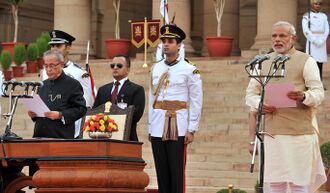
Modi was sworn in as Prime Minister of India on 26 May 2014 at the Rashtrapati Bhavan. He became the first Prime Minister born after India's independence from the United Kingdom. He was the first to invite all South Asian Association for Regional Cooperation leaders to attend his swearing-in ceremony. His first cabinet consisted of 45 ministers, 25 fewer than the previous UPA government. His first cabinet decision was to set up an SIT to address the issue of illegal money. He started a monthly radio program titled "Mann ki Baat" on 3 October 2014. He repealed 1,159 obsolete laws in first two years as compared to 1,301 such laws repealed by his preceding governments over a span of 64 years. As of May 2016, more than 1.04 crore people have been trained under Skill India Mission launched by him in 2015.
Economic policies
As Prime Minister, Modi announced measures to speed up the efficiency of India's economy and reform the red tape that had traditionally hindered Indian business, streamlining the bureaucratic requirements on companies such as a complex permit and inspection system and numerous regulations, so as to make business easier. Modi also ordered reform among the bureaucrats of the Indian Administrative Service to ensure a more efficient government bureaucracy. The Planning Commission was abolished and replaced with a think tank called NITI Aayog.
In October 2014, the Modi government deregulated diesel prices.
Modi's government also liberalised India's foreign direct investment policies, allowing more foreign investment in numerous industries. In May 2015, it was reported that foreign direct investment in India had risen 61% since the previous year. In September 2015, India was the world's top foreign direct investment destination, overtaking China and the United States. In November 2015, his government eased foreign investment regulations in 15 major sectors of the economy.
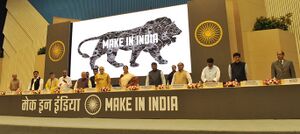
In September 2014, Modi introduced the Make in India initiative to encourage foreign companies to manufacture products in India, with the goal of turning India into a global manufacturing hub. Modi's government has increased infrastructure spending to massively expand the country's transportation infrastructure. Projects to improve and expand the country's road and railway networks were undertaken, with railway reform being among the government's top priorities. In November 2015, the Indian government signed major deals with General Electric and Alstom to supply India with 1,000 new diesel locomotives, which would be built in India as part of the "Make in India" scheme. In December 2015, Modi's government signed an agreement with Japan to jointly build a bullet train system linking Mumbai and Ahmedabad. The Indian government also began a massive expansion of India's highway network, and is intent on building transport links to remote areas. In addition, an expansion of the country's water transport network was put forward, with a plan on converting 101 rivers into national waterways for the transport of goods and passengers. Construction was started for new sea and river ports, and plans were drawn up for waterbus and hovercraft services.

Modi launched a flagship scheme for developing 100 smart cities on 25 June 2015. In addition to the smart cities initiative, Modi unveiled the "smart villages" initiative, under which rural villages will be given Internet access, clean water, sanitation, and low-carbon energy, with Members of Parliament overseeing the programme's implementation in select villages in their constituencies, other than their own or those of their relatives, with the goal of at least 2,500 smart villages by 2019.
On 22 January 2015, Modi launched two schemes - Beti Bachao, Beti Padhao Yojana and Sukanya Samriddhi Account. In June 2015, Modi launched the "Housing for All By 2022" project, which intends to eliminate slums in India by building about 20 million affordable homes for India's urban poor. In May 2016, he claimed that his government have been able to plug leakages worth across various schemes by identifying and stopping 1.62 crore fake ration cards.
In 2016, he announced his target to double the farmers income by 2022. He also launched Pradhan Mantri Fasal Bima Yojana in 2016.
Modi launched Pradhan Mantri Jan Dhan Yojana in August 2014, in which 21.90 crore accounts have been opened and an amount of have been deposited by 18 May 2016.
In 2016, Goods and Services Tax Bill was passed by the Parliament of India marking one of the biggest Economic reform in India.
On 9 November 2016, Modi's government demonetised the ₹500 and ₹1000 banknotes of the Mahatma Gandhi Series, with the stated intention of curbing corruption, black money, fake currency and terrorism.
Health and sanitation policies

Modi's government developed a draft policy to introduce a universal health care system, known as the National Health Assurance Mission. Under this plan, the government was to provide free drugs, diagnostic treatment, and insurance coverage for serious ailments, although budgetary concerns have delayed its implementation.
In October 2014, Modi launched the Swachh Bharat Abhiyan ("Clean India") campaign, a national cleanliness drive to eliminate widespread open defecation prevalent in rural areas, as well as reduce widespread littering throughout the country, so as to improve India's poor sanitary conditions. As part of the programme, a public awareness campaign against littering was launched, and the Indian government stepped up construction of toilets in rural areas, as well as efforts to encourage people to use them. The Indian government also announced a series of projects to build new sewage treatment plants.
Defence policy
Modi's government has increased defence spending to modernise and expand the Indian Armed Forces. In 2015, the military budget was raised by 11%.
Modi's government also negotiated a peace agreement with National Socialist Council of Nagaland to end a Naga insurgency in northwest India that had been ongoing since the 1950s.
War on terrorism
Modi declared Pakistan as an exporter of terrorism in domestic as well as international forums. He has asked the United Nations to define the "terrorism" and declare the supporters of terrorism. He enhanced the compensation for terror victims and included POK citizens in the scheme. In September 2016, he urged the BRICS to target and destroy funding channels of terrorist groups. On 29 September 2016, Indian Army conducted a surgical strike on terror launchpads in PoK.
IT policy
Modi also launched the Digital India programme, which aims to ensure that government services are available to Indians electronically so as to reduce the amount of paperwork, build infrastructure to ensure rural areas get high-speed Internet access, boost manufacturing of electronic goods in the country and promote digital literacy, including among the poor. He launched Digital India Week on 1 July 2015 in Delhi. In September 2015, Modi visited silicon valley in USA to meet the likes of Mark Zuckerberg, Sundar Pichai and Satya Nadella promoting the Digital India programme. Railway Stations across the country are being equipped with Wi-Fi technology.
International diplomacy
Modi invited leaders of the SAARC countries to his swearing-in as prime minister to strengthen ties among its member states. Continuing his efforts to promote close relationships with neighbouring countries, his first foreign visit as prime minister was to Bhutan. Modi visited Nepal on 8 August 2014, and began a five-day trip to Japan on 30 August. On 17 September 2014, Chinese President Xi Jinping arrived in India; financial memoranda of understanding and cooperation agreements between the countries were signed, which Modi called a new chapter in their economic relationship. The prime minister had a successful visit to the United States in the last week of September, which led to an improvement in relations between India and the US. In a 27 September 2014 address to the United Nations General Assembly Modi asked for the adoption of 21 June as International Yoga Day, and a resolution doing so was approved by the 193-member body. He celebrated the same by doing Yoga in Delhi in 2015 and in Chandigarh in 2016.
He announced an International Solar Alliance (ISA) at the CoP21 Climate Conference on 30 November 2015. India became a member of Missile Technology Control Regime in June 2016.
As of July 2016, Modi has completed 51 foreign trips as Prime Minister of India across 42 countries to strengthen Indian diplomatic relations with them. He became the first Indian PM to give official recogintion to Balochistan and Gilgit-Baltistan issue.
Personal life
In accordance with Ghanchi tradition, Modi's marriage was arranged by his parents when he was a child. He was engaged at age 13 to Jashodaben, marrying her when he was 18. They spent little time together and grew apart when Modi began two years of travel, including visits to Hindu ashrams. Reportedly, their marriage was never consummated and he kept it a secret because otherwise he could not have become a 'pracharak' in the puritan Rashtriya Swayamsewak Sangh (RSS). Although Modi kept his marriage secret for most of his career, he acknowledged his wife when he filed his nomination for a parliamentary seat in the 2014 general elections.
Image
Prime Minister Narendra Modi and President Barack Obama in a meeting at the White House.jpg|Prime Minister Narendra Modi and President Barack Obama in a meeting at the White House PM Modi shaking hands with Queen Elizabeth II at Buckingham Palace.jpg|Prime Minister Narendra Modi with Queen Elizabeth II. Prime Minister Narendra Modi with President Barack Obama at the Oval Office in White House. Also seen with Queen of the United Kingdom Elizabeth II
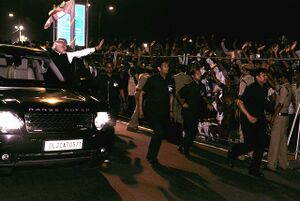
A vegetarian, Modi has a frugal lifestyle and is a workaholic and introvert. Adept at using social media, he has been since September 2014 the second-most-followed leader in the world (with over 17.9 million followers on Twitter as of February 2016), behind only Barack Obama. Modi's 31 August 2012 post on Google Hangouts made him the first Indian politician to interact with netizens on live chat.
Modi has also been called a fashion-icon with his signature, crisply ironed, half-sleeved tunic-shirt (dubbed the "Modi kurta"), brand-name accessories, and a suit with his name embroidered repeatedly in the pinstripes that he wore during a state visit by US President Barack Obama, drawing particular public and media attention, and sometimes criticism.
Although he is considered a controversial, polarising and divisive figure, British economist Jim O'Neill blogged that Modi is "good on economics" – one of the things "India desperately needs in a leader". In August 2013, financial analyst Chris Wood of CLSA wrote in his weekly "Greed & fear" report: "The Indian stock market's greatest hope is the emergence of Gujarat Chief Minister Narendra Modi as the BJP's prime ministerial candidate".
As prime minister, Modi has received consistently high approval ratings; at the end of his first year in office, he received an overall approval rating of 87% in a Pew Research poll, with 68% of people rating him "very favorably" and 93% approving of his government. His approval rating remained largely consistent at around 74% through his second year in office, according to a nationwide poll conducted by instaVaani. At the end of his second year in office, an updated Pew Research poll showed Modi continued to receive high overall approval ratings of 81%, with 57% of those polled rating him "very favorably."
Books
In 2001, Modi co-authored Setubandh, a biography of the RSS leader Lakshmanrao Inamdar. In 2007, a book comprising a collection of Modi's poems titled Aankh Aa Dhanya Chhe (Our Eyes Are So Blessed) was published. Modi also authored a book Karmayog which was a 101-page booklet. However, this book was not circulated that time because of election code of conduct. His Gujarati book titled Jyotipunj was published in 2008 and contains biographical profiles of various RSS leaders by whom he was inspired. The longest profile is of M. S. Golwalkar, under whose leadership the RSS expanded and whom Modi refers to as Pujniya Shri Guruji (meaning "Guru worthy of worship"). According to The Economic Times, his intention was to explain the workings of the RSS to his readers and to reassure RSS members that he remained ideologically sound. Modi has authored eight other books, mostly comprising short stories for children.
Awards and recognition
Modi was named Best Chief Minister in a 2007 nationwide survey by India Today. In March 2012, he appeared on the cover of the Asian edition of Time, one of the few Indian politicians to have done so, and made the 2014 Time 100 list of the world's most influential people.
Forbes Magazine ranked him the 15th-most-powerful person in the world in 2014 and the 9th-most-powerful person in the world in 2015.
In 2015, Modi was one of 30 most influential people on the internet" as the second-most-followed politician on Twitter and Facebook. That year, the magazine also ranked him eighth in its Person of the Year list. The same year saw him ranked fifth on Fortune magazine's second annual list of 'World's Greatest Leaders', which showed numerous changes from its first publication in 2014 because of its requirement that people who had been previously named had to "requalify with new achievements in the past 12 months".
State honours
 : State Order of Ghazi Amir Amanullah Khan, the highest civilian honor of Afghanistan, June 2016.
: State Order of Ghazi Amir Amanullah Khan, the highest civilian honor of Afghanistan, June 2016. : Member Special Class of the Order of Abdulaziz al Saud, April 2016.
: Member Special Class of the Order of Abdulaziz al Saud, April 2016.
References
External links
Official
- Official website (Prime Minister's office)
- Private website
- Official page on Bharatiya Janata Party's website

